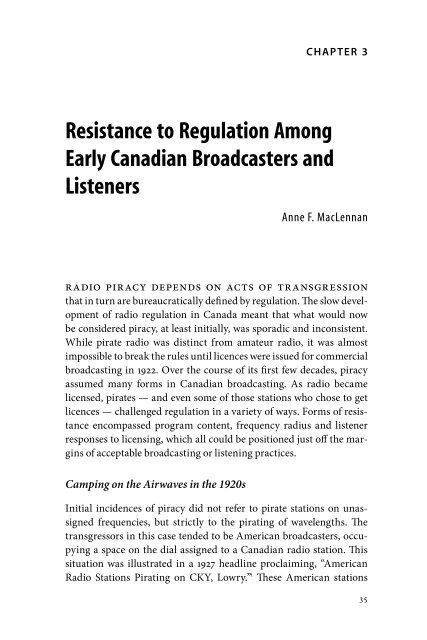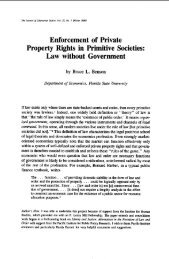- Page 2: Islands of Resistance
- Page 6: Islands of Resistance
- Page 9 and 10: 9. The Care and Feeding of Temporar
- Page 11 and 12: • islands of resistance Chapter 1
- Page 13 and 14: moss dance
- Page 15 and 16: • islands of resistance that we e
- Page 17 and 18: • islands of resistance UK, which
- Page 19 and 20: • islands of resistance in the ra
- Page 21 and 22: 10 • islands of resistance dian c
- Page 23 and 24: 12 • islands of resistance waves
- Page 25 and 26: 14 • islands of resistance detail
- Page 27 and 28: 16 • islands of resistance fiscat
- Page 29 and 30: 18 • islands of resistance began
- Page 31 and 32: 20 • islands of resistance ed. Ro
- Page 33 and 34: stephen dunifer Students building a
- Page 35 and 36: 24 • islands of resistance tin mi
- Page 37 and 38: 26 • islands of resistance the ra
- Page 39 and 40: 28 • islands of resistance includ
- Page 41 and 42: 30 • islands of resistance indica
- Page 43: 32 • islands of resistance range
- Page 48 and 49: abolished, and regulatory powers we
- Page 50 and 51: Resistance to Regulation • 39 vio
- Page 52 and 53: Resistance to Regulation • 41 unt
- Page 54 and 55: over licence fees became inextricab
- Page 56 and 57: ment in raids when they closed down
- Page 58 and 59: Resistance to Regulation • 47 14.
- Page 61 and 62: matta
- Page 63 and 64: 52 • islands of resistance ming s
- Page 65 and 66: 54 • islands of resistance almost
- Page 67 and 68: 56 • islands of resistance one be
- Page 69 and 70: 58 • islands of resistance rating
- Page 71 and 72: 60 • islands of resistance interv
- Page 73 and 74: 62 • islands of resistance months
- Page 75 and 76: 64 • islands of resistance nity v
- Page 77 and 78: 66 • islands of resistance tion p
- Page 79 and 80: 68 • islands of resistance object
- Page 81 and 82: gord hill
- Page 83: 72 • islands of resistance friend
- Page 86 and 87: CHAP TER 6 Awakening the ‘Voice o
- Page 88 and 89: Awakening the ‘Voice of the Fores
- Page 90 and 91: Awakening the ‘Voice of the Fores
- Page 92 and 93: Awakening the ‘Voice of the Fores
- Page 94 and 95: Awakening the ‘Voice of the Fores
- Page 96 and 97:
Awakening the ‘Voice of the Fores
- Page 98 and 99:
Awakening the ‘Voice of the Fores
- Page 100 and 101:
CHAP TER 7 Squatting the Airwaves P
- Page 102 and 103:
equipment, it was only a matter of
- Page 104 and 105:
Squatting the Airwaves • 93 now b
- Page 106 and 107:
Squatting the Airwaves • 95 be to
- Page 108 and 109:
Squatting the Airwaves • 97 inter
- Page 110 and 111:
gardener and the gatherer are not n
- Page 112 and 113:
CHAP TER 8 Amplifying Resistance Pi
- Page 114 and 115:
Amplifying Resistance • 103 wheth
- Page 116 and 117:
Amplifying Resistance • 105 how w
- Page 118 and 119:
Amplifying Resistance • 107 Radio
- Page 120 and 121:
Amplifying Resistance • 109 while
- Page 122 and 123:
Amplifying Resistance • 111 and w
- Page 124 and 125:
Amplifying Resistance • 113 stree
- Page 126 and 127:
Amplifying Resistance • 115 8. Da
- Page 128 and 129:
CHAP TER 9 The Care and Feeding of
- Page 130 and 131:
nomadism involves intention and a s
- Page 132 and 133:
The Care and Feeding of TAR • 121
- Page 134 and 135:
for me. Having it confiscated would
- Page 136 and 137:
The Care and Feeding of TAR • 125
- Page 138 and 139:
The Care and Feeding of TAR • 127
- Page 140 and 141:
The Care and Feeding of TAR • 129
- Page 142 and 143:
mous nature, continues to welcome n
- Page 144 and 145:
CHAP TER 10 The Voyage of a Gender
- Page 146 and 147:
The Voyage of a Gender Pirate and H
- Page 148 and 149:
The Voyage of a Gender Pirate and H
- Page 150 and 151:
The Voyage of a Gender Pirate and H
- Page 152 and 153:
The Voyage of a Gender Pirate and H
- Page 154 and 155:
The Voyage of a Gender Pirate and H
- Page 156 and 157:
CHAP TER 11 Pirate Radio and Maneuv
- Page 158 and 159:
Pirate Radio and Maneuver • 147 t
- Page 160 and 161:
Pirate Radio and Maneuver • 149 p
- Page 162 and 163:
Pirate Radio and Maneuver • 151 b
- Page 164 and 165:
Pirate Radio and Maneuver • 153 T
- Page 166 and 167:
Pirate Radio and Maneuver • 155 a
- Page 168 and 169:
Pirate Radio and Maneuver • 157 m
- Page 170 and 171:
Pirate Radio and Maneuver • 159 1
- Page 172 and 173:
CHAP TER 12 Touch That Dial Creatin
- Page 174 and 175:
The Project of Self-Realization is
- Page 176 and 177:
can improvise sense. It can give yo
- Page 178 and 179:
CHAP TER 13 The Art of Unstable Rad
- Page 180 and 181:
The Art of Unstable Radio • 169 w
- Page 182 and 183:
The Art of Unstable Radio • 171 c
- Page 184 and 185:
The Art of Unstable Radio • 173 w
- Page 186 and 187:
The Art of Unstable Radio • 175 a
- Page 188 and 189:
e considered abject sound alternate
- Page 190 and 191:
The Art of Unstable Radio • 179 w
- Page 193 and 194:
The micro radio project flyer krist
- Page 195 and 196:
184 • islands of resistance what
- Page 197 and 198:
186 • islands of resistance comme
- Page 199 and 200:
188 • islands of resistance limit
- Page 201 and 202:
190 • islands of resistance radio
- Page 203 and 204:
192 • islands of resistance 3. Pa
- Page 205 and 206:
The Mysterious Death of WB, present
- Page 207 and 208:
196 • islands of resistance ing p
- Page 209:
198 • islands of resistance sider
- Page 212 and 213:
CHAP TER 16 The Power of Small Inte
- Page 214 and 215:
The Power of Small • 203 kathryn
- Page 216 and 217:
The Power of Small • 205 sounds o
- Page 218 and 219:
quite restrictive of individual cit
- Page 220 and 221:
The Power of Small • 209 kathy ke
- Page 223 and 224:
jesse gertes
- Page 225 and 226:
214 • islands of resistance munic
- Page 227 and 228:
216 • islands of resistance KOGAW
- Page 229 and 230:
218 • islands of resistance porat
- Page 231 and 232:
220 • islands of resistance ing.
- Page 233 and 234:
222 • islands of resistance FX: C
- Page 235 and 236:
224 • islands of resistance MUTEB
- Page 237:
226 • islands of resistance Gener
- Page 241 and 242:
230 • islands of resistance • Y
- Page 243 and 244:
232 • islands of resistance Berla
- Page 245 and 246:
234 • islands of resistance Graeb
- Page 247 and 248:
236 • islands of resistance viewA
- Page 249 and 250:
The Contributors stephen dunifer is
- Page 251 and 252:
240 • islands of resistance ism.
- Page 253 and 254:
242 • islands of resistance terri
- Page 255:
new star books ltd. 107 — 3477 Co



